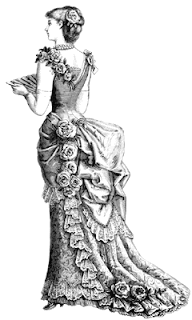Historically, there are only two types of garments: draped and tailored. Draped garments are the earliest type of garments and were common in the Egyptian, Mesopotamian, Greek and Roman civilizations.[1]
The first image is a depiction of Egyption Royal clothing. The vast majority of Egyptian clothing was made out of linen. However, the Royal Egyptians also used very fine muslin. Both men and women wore tunic and robe draped garments. Men also wore loincloths called shenti "a scarf wrapped around the kidneys and held by a belt".[2]

Like the Egyptians, the Romans also wore draped clothing in the form of the tunic made from wool. Roman male citizens later wore togas and Roman women wore stolas (essentially a long toga that reached the ground).[4] The Romans also imported fine silks from the Orient and linen and cotton from Egypt and colored fabrics became common. For the Romans, dress particularly signified social status within the society. The image below depicts Roman clothing styles symbolizing rank within the society: citizen, matron, curule magistrate, emperor, general, workman, and slave.[5]
 One of the most famous movies of all time depicting the most exalted Queen of Egypt and the most renowned Dictators of Rome is the 1963 film, Cleopatra. Cleopatra was a four-time Academy Award winner with an all star cast including Elizabeth Taylor as Cleopatra, Rex Harrison as Julius Caesar, and Richard Burton as Marc Antony. While the Hollywood costumes are a bit ostentatious, they do display a modern interpretation of both Egyptian and Roman dress.
One of the most famous movies of all time depicting the most exalted Queen of Egypt and the most renowned Dictators of Rome is the 1963 film, Cleopatra. Cleopatra was a four-time Academy Award winner with an all star cast including Elizabeth Taylor as Cleopatra, Rex Harrison as Julius Caesar, and Richard Burton as Marc Antony. While the Hollywood costumes are a bit ostentatious, they do display a modern interpretation of both Egyptian and Roman dress. 


Today, garments are still considered either draped or tailored or a combination of the two. The below image displays modern draped garments.

Tailored garments were first developed by the Northern European cultures: the Celts, Britons, Gaels, and Normans. Tailored garments helped these ancient people survive the extremely cold weather conditions in which they lived.[6] The ancient Celts were very sophisticated weavers who made their garments out of wool, linen and leather and used brightly colored dyes. These materials were woven into long-sleeved tunics, breeches and cloaks.[7] Although the Greeks and Romans considered the Celts, and other Northern Europeans, “Barbarians”, the Romans did outfit their legions with breeches or trousers, a style they acquired from Northern European cultures.[8]
 The above image displays a Celtic warrior in breeches and long-sleeved tunic. The image below is a modern day interpretation of ancient Celtic warrior dress.
The above image displays a Celtic warrior in breeches and long-sleeved tunic. The image below is a modern day interpretation of ancient Celtic warrior dress.
From these Northern European cultures, highly-sophisticated forms of garment tailoring developed that were more complex than the Mediterranean forms. As they excelled in their weaving quality, the Northern European tailoring emphasis was on "craftsmanship and finishes based on embroideries and lace-making".[9] The image below depicts 14th century garment tailoring from the Northern European School of Tailoring.


.jpg)
[1] http://discussion.academyart.edu/sectionContent/54-23431/27072/session_03.html








































